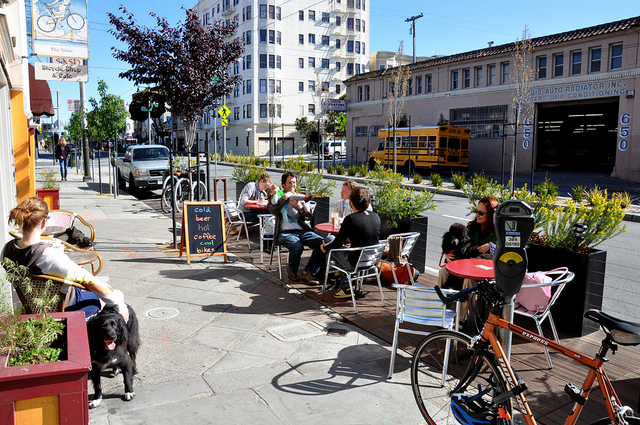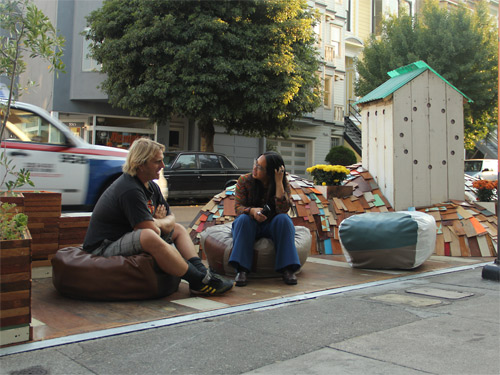(Last week may have been tax policy week at Createquity, but it doubled as John Carnwath week, as both of the articles he’s written for the site were featured. So this week we’re following suit with three articles by Jackie Hasa, who likewise joined the Createquity editorial team in June. This one was Jackie’s first article for the Createquity Fellowship back in March 2012 – an examination of the phenomenon of parklets in San Francisco and their implications for the arts. – IDM)

The original PARK(ing) Day parklet. Credit: Rebar
In the last year, parklets have taken San Francisco by storm. At the start of 2011, San Francisco had four of these sidewalk-adjacent, itty-bitty public spaces created by repurposing parking spots. Now there are more than 20, with dozens of others in various stages of review. Other cities, including New York, Long Beach, Los Angeles, Philadelphia, and Vancouver have taken notice of this phenomenon as a cheap, flexible way to enliven their streets with small seating areas and green spaces. Their importance for even non-design-oriented arts organizations is twofold: 1) their evolution from guerilla art action to policy success can serve as a blueprint in other arenas; and 2) parklet programs in development present opportunities for local arts organizations to shape these urban interventions to serve their communities.
While urban planners laud parklets as revolutionary uses of public space, their short evolution from the original PARK(ing) Day in 2005 to a celebrated piece of city policy in 2011 is perhaps just as astonishing. PARK(ing) Day began in San Francisco, when the design collective Rebar paid a parking meter, set up some sod, a tree, and a bench, and used the space as a park until the two hours on the meter ran out. Then, they rolled up the sod, and the space went back to its original car-oriented purpose. By 2011, it had turned into a decentralized worldwide event, in which thousands of individuals and groups created 975 informal parks for a day across six continents. In San Francisco, the Pavement to Parks program now officially supports the development of more permanent parklets with a permitting process and guidelines. Among other things, the guidelines stipulate that all parklets are sponsored and managed by a private partner, all seating must remain available for public use, and at least some of the seating must be permanent.

The first official parklet in San Francisco, at Mojo Bicycle Cafe on Divisadero. Credit: Jeremy A. Shaw
Although there has been a great deal of support for parklets, thus far, most in San Francisco don’t quite fulfill their promise. Arts organizations have a fantastic opportunity to improve upon their current form. The requirement for a local business steward means that parklets often end up serving as little more than well-designed outdoor seating areas for cafes or restaurants, albeit technically open to the public. In a review of 19 parklets, John King, the San Francisco Chronicle’s architecture critic, found that fifteen are managed by a cafe or restaurant, two are managed by other businesses, and one is adjacent to a private home. The 19th? An example to us all: the art gallery Fabric 8 is managing its own parklet, which will host art installations that rotate each year. The current installation, by Erik Otto, is available for purchase and can be moved to another location at the close of its exhibition at Fabric 8.
Arts organizations in San Francisco and elsewhere should follow Fabric 8’s example and push for parklets that support public programs rather than supplement local businesses. A California Planning and Development Report already contains the kernel of a great idea–the creation of a sponsorship program to cover the $5,000-$10,000 in parklet start-up costs for worthy organizations that can’t afford it. Other possibilities include the coordination of parklet design to enhance (or generate!) arts districts, the development of a single permit to utilize all of a neighborhood’s parklets for a mobile arts event, the formation of new arts-business partnerships for parklet stewardship, or the creation of parklets specifically for performance. Parklets represent a version of place-based community development that even small arts organizations can deploy to achieve great impact.
